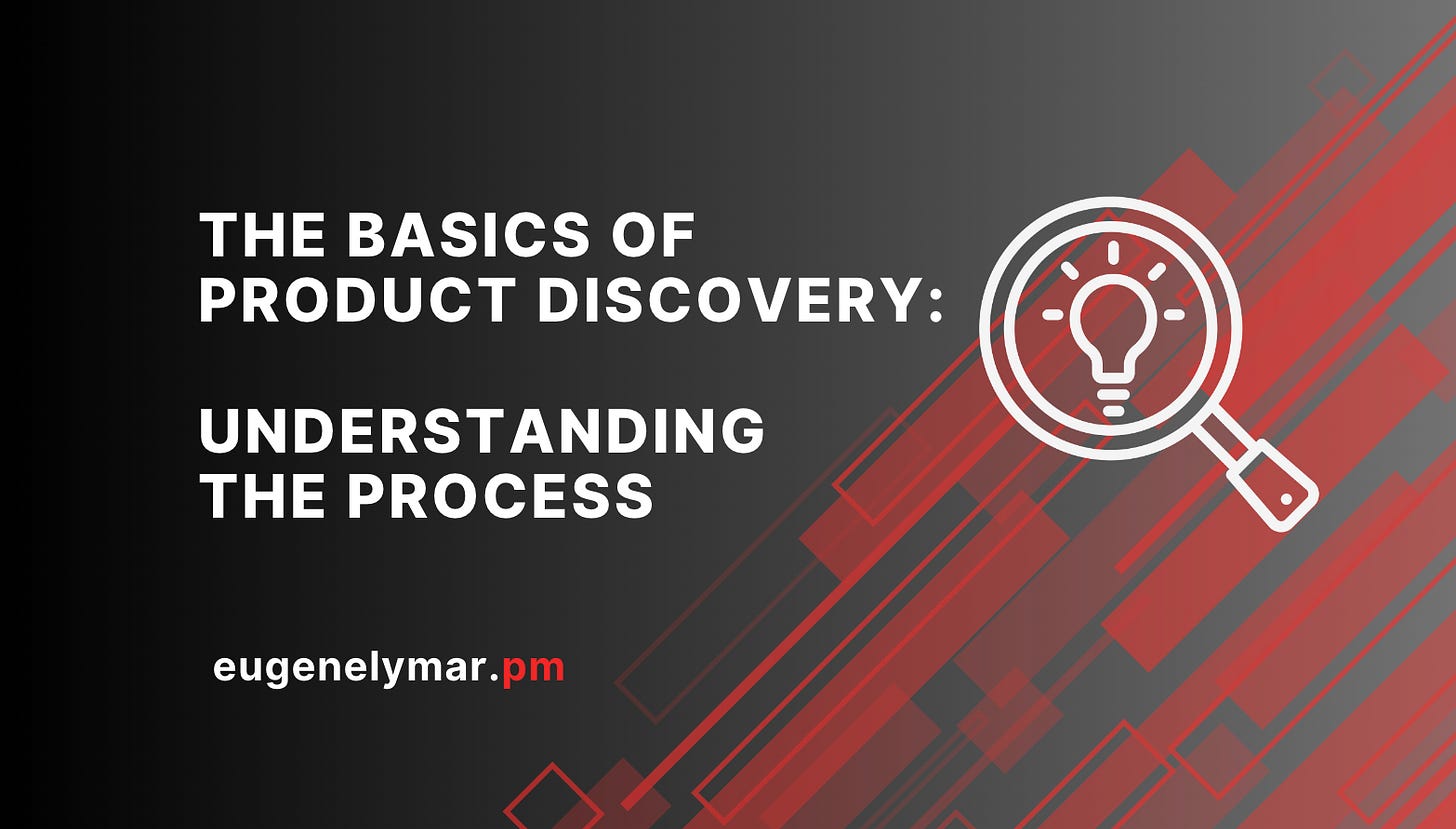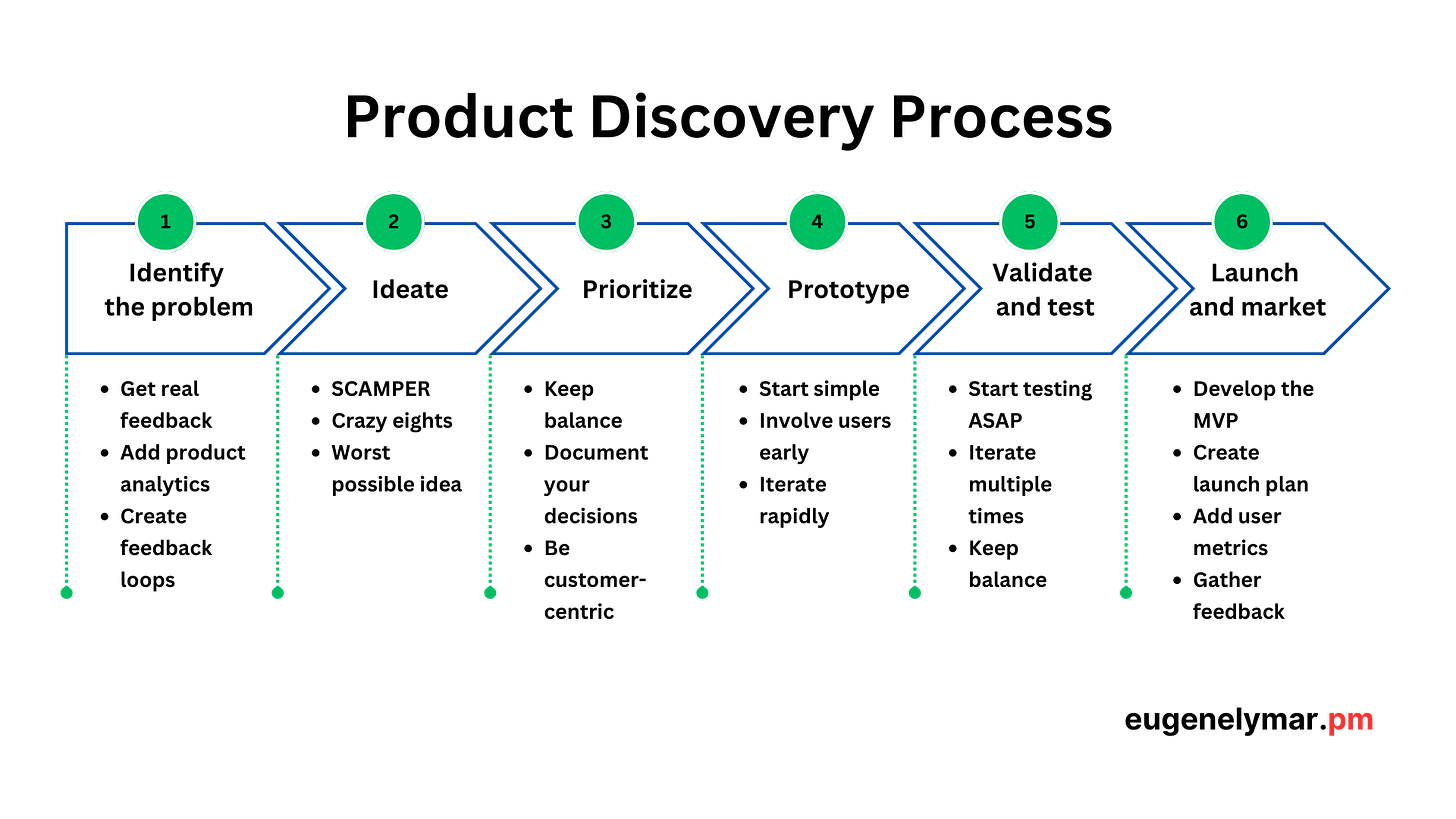The Basics of Product Discovery: Understanding the Process
What is product discovery?
Product discovery is a process that helps you better understand customer needs, pain points, and ways to solve them using your product.
Why do you need product discovery?
You need it to build better products at lower-cost, to create products that people need. Many product managers don’t do product discovery because they do not understand how important it is. There are thousands of products with features that nobody uses, and there are thousands of beloved products as well. The difference between them lies in doing product discovery - when you identify a problem and validate it with users before actually developing a feature.
Let’s dive deeper in this process.
Stages of Product Discovery
There is no single approach to product discovery. It may vary greatly from company to company and product to product. I personally define the following universal stages:
Problem identification
Ideation
Prioritization
Prototyping
Testing and validation
Launch and marketing
Problem identification
Everything starts with identifying a problem or multiple problems to ensure that your product addresses real customer needs and delivers value.
If we rewind the time and get back to the problems that led to the appearance of Uber, we will see that everything was around deep customer understanding:
Difficulty to quickly find a taxi especially during peak times.
Lack of transparency in pricing.
No real time tracking of the taxi and absence of information about drivers.
Having addressed these issues, Uber became revolutionary in the transportation industry. It was able to leverage the existing technology and enhance convenience and transparency for both drivers and passengers.
Practical tips
There are several viable strategies to identify customer problems:
Always prioritize interaction with your users to get real feedback. This may include user interviews or surveys.
Add product analytics (Amplitude, Hotjar, Mixpanel or similar). It helps you reveal patterns that are not immediately obvious. I love working with product analytics.
Create feedback loops. Stay in touch not only with your customers, but also with internal teams to continuously gather and refine problem insights.
Ideation
Having identified the problem, you start brainstorming and generate possible solutions. The goal of ideation is to review ideas and prioritize the most valuable ones.
This is a collaborative activity that involves different stakeholders - internal teams, customers, partners to bring diverse perspectives and ensure a broad range of insights.
Here are some techniques for generating ideas:
SCAMPER, which is the acronym for Substitute, Combine, Adapt, Modify, Put to another use, Eliminate, and Reverse. This is an excellent approach to break the ice and start exploring new possibilities.
Crazy eights is a sketching exercise where participants draw eight different ideas in eight minutes.
Worst possible idea. I prefer this one - the participants provide the worst possible solutions to the problem. In some cases you need this approach to boost your creative thinking.
To summarize this section, be creative, find balance between creativity and practicality, iterate quickly and do not forget to document the ideas.
Prioritization
Having a bunch of generated ideas, you must somehow prioritize them. You should take into account feasibility, impact and their alignment with customer needs.
There are a few good techniques to prioritize your ideas:
Dot voting. This technique is simple but at the same time very powerful. All team members receive a set of dots or stickers of different colors with each color meaning different priority. When voting starts, team members place their dots on the options they consider most important.
MoSCoW. I wrote about this technique and other techniques in the How to Build Your First Roadmap - A Step-by-Step Guide and Free Roadmapping Tools article. This is again an acronym - MoSCoW stands for Must, Should, Could, and Would.
+ KANO, RICE, ICE Scoring, value vs. complexity and other.
Practical tips
When prioritizing the ideas, make sure to keep these considerations in your head:
Balance between quick wins and strategic goals. Sometimes you must quickly demonstrate the results, while in other cases you keep sticking to the long-term strategic goals.
Always document your decisions because you may forget why you have prioritized a certain idea over other ones.
Use the data when doing prioritization - feature impact, possible ROI, number of affected users or deal amount may become the decisive factors.
And be customer-centric. Always.
Prototyping
This is the next crucial step in the product discovery process. At this point, you create a visual representation of your ideas in the form of wireframes, mockups or even clickable prototypes. Prototyping helps you to get early feedback, identify possible issues and iterate quickly.
There are different tools for prototyping:
Figma - Figma - a recognized industry leader. Requires basic knowledge in design.
Miro - a universal online whiteboard. Good for beginners.
Sketch - niche product for MacOS users.
Canva - the most user-friendly tool for total beginners.
I don’t have design experience, so I use Miro or Canva for prototyping.
Practical tips
Start simple, involve users early and iterate rapidly. You don’t need to create a state-of-art product/feature design at this stage. Even crude wireframes may have significant impact on further development.
All you need is to visually demonstrate the idea and get rapid feedback.
Testing and validation
The next stage in the product discovery and development process is testing and validation. At this stage, you focus on gathering feedback from users and stakeholders to assess the usability, functionality and overall viability of the prototype created.
During prototype evaluation you conduct usability testing sessions with real users, having them interact with the prototype. You observe how users navigate through the interface, understand its functionality, and identify any usability issues.
Practical tips
From my experience, the testing and validation is crucial to ensure the product meets user expectations as well as business objectives.
Start testing as soon as you have a usable prototype. Early feedback helps in identifying fundamental issues that can be addressed early in the development process.
Be prepared to iterate multiple times based on user feedback and stakeholder input. You should refine your prototype until it meets user needs.
While your product vision is important, there must be a balance between the initial vision and real-world feedback.
Launch and marketing
The final stage of product discovery is launch and marketing. At this point, you introduce your product to the market and begin promoting it to prospective customers. It’s essential to identify your target audience, set pricing, and formulate a marketing plan. Additionally, you should establish a brand identity for your product and create packaging and promotional materials.
The effort put into enablement proves valuable here, as other business departments are already informed about the upcoming product and can offer their support seamlessly.
Instead of a conclusion
In the ideal world, all products are created using the discovery process. In real world… well… you should at least start incorporating some discovery elements into your product development process.
All steps are equally important, but some of them require less efforts than others.
Reach out to your customers, do prototyping, iterate.
Please subscribe to support my work. If you have any questions, connect with me using:




